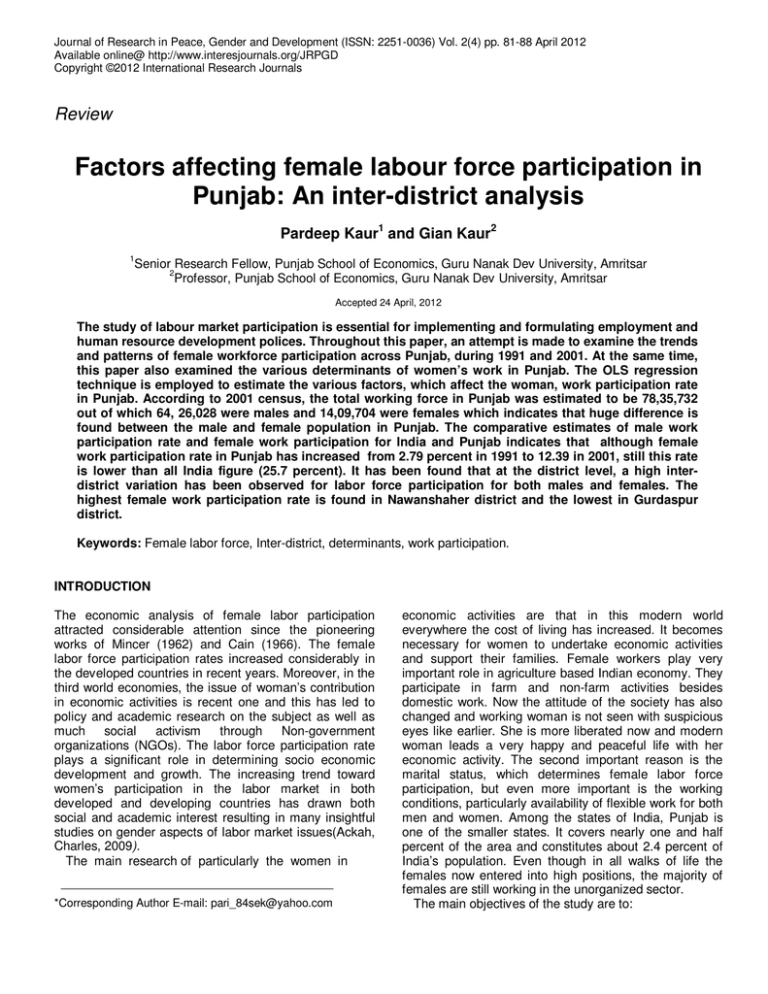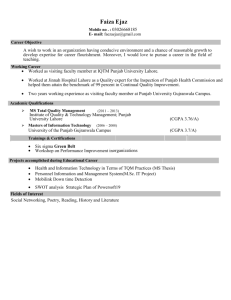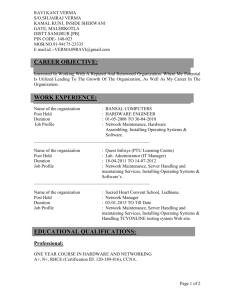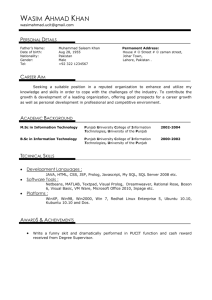Document 14249733
advertisement

Journal of Research in Peace, Gender and Development (ISSN: 2251-0036) Vol. 2(4) pp. 81-88 April 2012 Available online@ http://www.interesjournals.org/JRPGD Copyright ©2012 International Research Journals Review Factors affecting female labour force participation in Punjab: An inter-district analysis Pardeep Kaur1 and Gian Kaur2 1 Senior Research Fellow, Punjab School of Economics, Guru Nanak Dev University, Amritsar 2 Professor, Punjab School of Economics, Guru Nanak Dev University, Amritsar Accepted 24 April, 2012 The study of labour market participation is essential for implementing and formulating employment and human resource development polices. Throughout this paper, an attempt is made to examine the trends and patterns of female workforce participation across Punjab, during 1991 and 2001. At the same time, this paper also examined the various determinants of women’s work in Punjab. The OLS regression technique is employed to estimate the various factors, which affect the woman, work participation rate in Punjab. According to 2001 census, the total working force in Punjab was estimated to be 78,35,732 out of which 64, 26,028 were males and 14,09,704 were females which indicates that huge difference is found between the male and female population in Punjab. The comparative estimates of male work participation rate and female work participation for India and Punjab indicates that although female work participation rate in Punjab has increased from 2.79 percent in 1991 to 12.39 in 2001, still this rate is lower than all India figure (25.7 percent). It has been found that at the district level, a high interdistrict variation has been observed for labor force participation for both males and females. The highest female work participation rate is found in Nawanshaher district and the lowest in Gurdaspur district. Keywords: Female labor force, Inter-district, determinants, work participation. INTRODUCTION The economic analysis of female labor participation attracted considerable attention since the pioneering works of Mincer (1962) and Cain (1966). The female labor force participation rates increased considerably in the developed countries in recent years. Moreover, in the third world economies, the issue of woman’s contribution in economic activities is recent one and this has led to policy and academic research on the subject as well as much social activism through Non-government organizations (NGOs). The labor force participation rate plays a significant role in determining socio economic development and growth. The increasing trend toward women’s participation in the labor market in both developed and developing countries has drawn both social and academic interest resulting in many insightful studies on gender aspects of labor market issues(Ackah, Charles, 2009). The main research of particularly the women in *Corresponding Author E-mail: pari_84sek@yahoo.com economic activities are that in this modern world everywhere the cost of living has increased. It becomes necessary for women to undertake economic activities and support their families. Female workers play very important role in agriculture based Indian economy. They participate in farm and non-farm activities besides domestic work. Now the attitude of the society has also changed and working woman is not seen with suspicious eyes like earlier. She is more liberated now and modern woman leads a very happy and peaceful life with her economic activity. The second important reason is the marital status, which determines female labor force participation, but even more important is the working conditions, particularly availability of flexible work for both men and women. Among the states of India, Punjab is one of the smaller states. It covers nearly one and half percent of the area and constitutes about 2.4 percent of India’s population. Even though in all walks of life the females now entered into high positions, the majority of females are still working in the unorganized sector. The main objectives of the study are to: 82 J. Res. Peace Gend. Dev. (i) Examine the pattern of female labor force at the district level in Punjab between 1991 and 2001 and to (ii) Indentify the determinants of female labor force participation in Punjab. It has been well demonstrated in the literature that labor force participation rate of women is the result of many factors. Therefore, this study is an effort to indentify the socio-economic and demographic factors, which determine the women workforce participation rate. This study is organized into six sections. Introduction is presented in Section I. In Section II, review of existing literature on female workforce is discussed. In Section III, we have presented the database and methodology. Section IV provides the nature and pattern of employment in Punjab as well as in its various districts. Section V presents the findings of regression analysis while in last section presents some concluding remarks and suggestions. Review of literature In this section, an attempt is made to review literature on studies relating to working women at national and international level. Sahoo and Mohanty (1978) tried to analyze the interdistrict variation in female participation in Orissa on the basis of data from 1971 census. They worked out the correlation coefficient of female participation rate with various variables such as male population, percentage of Scheduled caste / Tribes, education. They found positive but insignificant correlation sex ratio and concluded that in those districts where population of SC and ST was less, female participation rate (FPR) was also high. The findings of the study suggest that no single variable satisfactory explains the differences. The difference may be due to a host of causes such as social, economic, geographical, and cultural. B.S Panghal and Mange Ram 1985) conducted a study to examine the nature and extent of employment pattern of woman labor on farms in different agro climatic zones of Haryana state. The study has revealed that as the size of the farm increased, the participation of women labor also increased. Naqvi and Shahnaz (2002) have analyzed the effects of various demographic, socio-economic, and human capital related factors on women participation in economic activities. They applied probit and multinomial logit model to estimate the parameters. The findings indicate that marital status, primary education, number of children and female head of households are inversely related with women’s participation in economic activities. Zareen and Lubna (2002) Women’s economic participation is significantly influenced by factors like their age, education, marital status. Employment status of the head of the household (generally a male), presence of male member, and children of ages 0-5 are also important variables that significantly affect women’s participation in economic activities. Giavazzi and others (2009), used panel data collected from the World Value Survey, studied whether cultural attitudes towards work, gender, and the young are significant determinants of the evolution over time of the employment rate of women. They found that attitudes towards a women’s role in the family are statistically and economically important determinants of the female rate of employment. Aslam and others (2008) found a similar strong association between higher education and female labor force participation for Pakistan. Shaheen, Safana (2011) investigated the patterns of female labor force participation in case of Pakistan. The study utilized Multiple Indicator Cluster Survey 2007-08 data of Punjab. The variables used in the analysis are female labour force participation, age, age square, marital status, area, female monthly income, family monthly income, family size, household head education, different classes of female education and employment status. Results of Logit model depicts that household head education, primary, middle, matric & mudrassa education level is negatively related with the decision of female labor force participation while, decision towards participation is strong if female belonged to urban area, if she is married, if she has higher education, and if she has large family size. Faridi et al., (2011) by used the data of Bahawalpur (district of Punjab, Pakistan) and found that women’s selfemployment is positively related with age and experience. Analysis of various education level shows that women who have low-level education highly tends towards self-employment than women who have high level of education. Maglad (1998) used demographic survey of Sudan for the period of 1990-91and found that education is positively and significantly related with female decision to enter for work in market. Moreover, female labor force participation is positively related with own wage and negatively related with spouse’s wage, assets, and having small children. DATA BASE AND METHODOLOGY The present study is based on the secondary data and the required data of the study has been taken from the various issues of Statistical Abstract of Punjab, Human Development Report of Punjab (2004) and Ministry of women and Child Development. Theoretically, there are number of demographic and economic factors which can be included in the study as a possible determinant of FLFP but due to availability of district wise data we have included male work participation rate (MWPR), Sex-ratio (SR) Female literacy rate(FLR). Following Mazumdari and Guruswamy (2006) data for 1991 and 2001 is used (to increase sample size) by taking time as a continuous dummy variable. FLFP=α+ βiXis+Dt+U Where Dt =0 for 1991 Kaur and Kaur 83 Dt = 1 for 2001 Where Female labor force participation rate (FLFP) is the dependent variable and X’s are the independent variables, explaining variations in female’s labor force participation rate. α shows the intercept and βi provides the estimated co-efficient of the respective repressor and U is the constant variance disturbance term. Women and work in punjab Since the post independence period, Punjab has witnessed a high level of economic prosperity, which has resulted in high per capita income. However, the higher level of economic development did not improve economic and social status of women in Punjab. The poor status of women in Punjab is reflected through the gender development index (GDI), which estimates the unequal achievements of men and women using the same three dimensions that are captured in the HDI (Human Development Index) . HDI is a simple average of three dimensions indices each of which measures average achievements in a country with regard to‘ A long and healthy life’ Knowledge’ and‘ decent standard of living” (Ministry of women and child development , 2009) while UNDP’s Human Development Index using three indices: Life Expectancy at birth, educational attainment and per capita GDP. GDI adjusts the average achievement in the same three dimensions that are captured in the HDI to account for inequalities between men and women. Table 1 reveals the HDI and GDI of Punjab and different states of India, which has been measured by the Ministry of Women and Child Development, Government of India in 2009. According to this report, gender disparities exist in the state if GDI score is less than the HDI score and equal to HDI if there is no gender disparity. The table reveals that although gender disparity was lower in Punjab than national average (0.015) but still there exists gender disparity. Punjab recorded the lowest participation rates over the decades from 1981 to 2001. Female labor force participation rate (FLFP), a useful measure of economic activity is generally computed as the ratio of the female labor force (employed and unemployed but seeking work) to the female Population. This rate refers to the probability that a female works. The number of females employed includes those who are in paid employment and those who are unpaid family laborers. Women working on the family farm or business are considered economically active and thus counted in the labor force (Tansel, Aysıt, 2002). In Punjab women are relatively, contribute insignificant role in workforce. Notwithstanding the high level of development and education in Punjab, Punjab has the lowest female workforce participation in the country (Human Development Report Punjab, 2004). According to 2001 census, the total working force in Punjab was estimated to be 78, 35,732 out of which 64, 26028 were males and 14, 09704 were females. Table 2 provides the census wise workforce in rural as well as in urban areas in Punjab during 1991 and 2001. It has been clear from the table that in rural areas the female labor force grown at faster rate than the urban female labor population rate. The table also shows that huge difference is found between the male and female participation rate in Punjab during 1991 and 2001. Table 3 depicts the comparative estimates of MWPR and FWPR for India and Punjab in 1991 and 2001. From table 2, it is clear that WPRs have increased for both India and Punjab between the period 1991 and 2001. In the same period, female work participation rate in Punjab no doubt, have increased but this rate is lower than all India figure. Generally, it has been recognized that nature of disparity among the districts over time is a pre condition to analyze the work-participation rates at the district level. Therefore, we have calculated the co-efficient of variation for the period 1991 and 2001. The co-efficient of variation indicates the ratio of standard deviation to its mean expressed in percentage terms. The higher ratio represents an increasing disparity among the districts. In Table 3 we presented the district-level FWPR and MWPR for 1991 and 2001. In 1991, the co-efficient of variation among districts for female workers have turned out to be 37% but it has declined to 27 percent in 2001. For male workers it has declined from 3.53 percent to 3.43 percent. Table 4 clearly shows that the total work participation rate has increased in all the districts of the state during 1991-2001. According to 2001 census, the highest FWPR is found in Nawanshaher district and the lowest in Gurdaspur district. FWPR for the state as a whole has increased from 4.4 percent in 1991 to 18.7 percent in 2001. Table 3 shows that female WPR has increased in all the districts of the state, whereas male WPR has increased in some districts, decreased in some others and remained the same in the rest. This can partly be attributed to the level of changes in the growth of different sectors in various districts. However, there has been a significant increase in the proportion of female marginal workers during the decade. Between Indian States and Union Territories, Punjab ranked 24th, 14th, and 26th respectively during 2001 in terms of the total, male and female workers. Table 5 provides the figures at the district level for the main and marginal workers in Punjab. From the table it is clear that there has been decline in the marginal workers for women from 91 percent to 59 percent during the last decade. The decrease is comparatively more found in the districts of Ludhiana, Kapurthala and Jallandhar. Table 5 further reveals that of the total marginal workers 59 percent marginal workers are females. In the category of marginal workers, Mansa ranks at the top with 74 percent female marginal workers, while Jallandhar has the lowest percentage of female marginal 84 J. Res. Peace Gend. Dev. Table 1. HDI and GDI score differences and ranks for states/UTs, 2006 State HDI Rank GDI Rank HDI and GDI differences Andhra Pradesh 0.585 28 0.574 27 0.011 Arunchal Pradesh 0.647 20 0.642 18 0.005 Assam 0.595 26 0.585 26 0.010 Bihar 0.507 35 0.479 35 0.028 Goa 0.764 2 0.747 2 0.017 Gujarat 0.634 23 0.624 22 0.010 Haryana 0.643 21 0.632 20 0.011 Himachal Pradesh 0.667 15 0.664 13 0.004 Jammu & Kashmir 0.590 27 0.568 28 0.021 Karnataka 0.622 25 0.611 25 0.011 Kerla 0.764 2 0.745 3 0.018 Madhya Pradesh 0.529 33 0.516 33 0.013 Mahrashtra 0.689 11 0.677 10 0.102 Manipur 0.702 7 0.699 6 0.003 Meghyla 0.629 24 0.624 23 0.005 Mizoram 0.688 12 0.687 9 0.002 Nagaland 0.700 8 0.697 7 0.003 Orissa 0.537 32 0.524 32 0.013 Punjab 0.668 14 0.663 14 0.005 Rajasthan 0.541 31 0.526 31 0.015 Sikkim 0.665 17 0.659 15 0.006 Tamil Nadu 0.666 16 0.655 16 0.011 Tripura 0.663 18 0.626 21 0.037 Uttar Pradesh 0.528 34 0.509 34 0.019 West Bengal 0.642 22 0.622 24 0.020 Chhattisgarh 0.549 30 0.542 30 0.008 Jharkhand 0.574 29 0.558 29 0.017 Utthrakhnd 0.652 19 0.647 17 0.005 Adman & Nikobar 0.708 6 0.692 8 0.016 Chandigarh 0.784 1 0.763 1 0.020 Dade 0.677 13 0.673 12 0.004 Daman 0.700 9 0.677 11 0.024 NCT Delhi 0.740 4 0.701 5 0.039 Lakshadweep 0.690 10 0.635 19 0.062 Pondicherry 0.725 5 0.706 4 0.029 All India 0.657 0.632 0.015 Source: Ministry of Women and Child Development, Government of India, 2009 Kaur and Kaur 85 Total UrbanRural Area Table 2. Female Workforce participation rate in Punjab: 1991-2001 Year No. of Workers Male Female Total population Male Female 1991 2001 1991 2001 1991 2001 4157285 4161003 1675567 2265025 5832852 6426028 7569423 8516596 3208611 4468449 10778034 12985045 145465 1087222 120057 322482 265522 1409704 6719321 7579892 2784614 3794062 9503935 11373954 MWPR %of Male workers 54.92208587 48.85758348 52.22094545 50.68928839 54.1179588 49.48791475 FWPR %of Female Workers 2.164876481 14.34350252 4.31144137 8.499650243 2.793811195 12.39414191 Source: Statistical Abstract of Punjab, Various Issues Table 3. Work Participation Rate in India and Punjab in 1991 and 2001 Table, 2: Work Participation Rate in 1991 and 2001 MWPR FWPR State/ Country 1991 2001 1991 2001 India 51.6 49.48 22.3 25.7 Punjab 54.22 2.79 4.40 12.39 Source: Census of India, 2001 Table 4. Female and Male Workforce participation rate in Punjab: 1991-2001 FWPR MWPR District 1991 2001 1991 2001 Gurdaspur 2.4 12.7 51.3 51.9 Amritsar 2.7 16.3 55.0 53.2 Kapurthala 5.8 14.1 54.0 53.4 Jalandhar 4.6 12.3 53.0 54.1 Nawanshehar 4.0 33.0 53.0 55.6 Hoshiarpur 4.7 17.3 50.6 51.0 Rupnagar 4.6 23.8 52.2 52.8 Ludhina 2.6 15.7 55.5 55.9 Firozpur 7.4 18.5 54.5 53.6 Faridkot 6.8 23.0 55.7 59.5 Muktsar 7.1 22.3 56.8 55.2 Moga 4.5 24.2 55.1 54.3 Bathinda 7.1 17.0 55.5 55.4 Mansa 7.5 25.1 57.6 54.4 Sangrur 4.7 24.1 56.3 54.9 Patiala 4.1 17.6 53.2 54.1 Fathegarh Sahib Punjab 2.1 18.3 54.7 55.1 4.4 18.7 54.2 54.1 C.V 37.5 28.0 3.53 3.43 Source: Statistical Abstract of Punjab 86 J. Res. Peace Gend. Dev. Table 5. Female main and marginal workers in Punjab (percentage) Main workers Marginal workers District Gurdaspur Amritsar 199 1 3 4 200 1 12 15 Cha nge 9 11 199 1 83 79 2001 47 55 Chang e -36 -24 Kapurthala 5 16 10 94 48 -46 Jalandhar Nawanshehar 5 3 14 33 8 30 91 96 46 59 -45 -37 Hoshiarpur 5 18 13 86 53 -33 Rupnagar 5 27 22 93 57 -36 Ludhina 4 17 13 97 50 -47 Firozpur 5 15 10 95 66 -29 Faridkot 5 20 15 96 59 -37 Muktsar 5 20 15 96 70 -25 Moga 5 23 18 96 61 -35 Bathinda 4 21 16 96 73 -23 Mansa 4 19 15 95 74 -21 Sangrur 3 20 17 96 67 -29 Patiala 5 17 12 86 60 -26 Fathegarh Sahib 2 18 16 80 54 -26 Punjab 4 19 15 91 59 -32 Source: Statistical Abstract of Punjab, various issues Table 6 . District wise female literacy rate in Punjab, 2001 Total Literacy Rate Female Literacy Rate District Gurdaspur Amritsar 1991 61.84 58.08 2001 73.8 70.4 1991 53.33 50.1 2001 67.1 65.2 Kapurthala Jalandhar Nawanshehar 63.31 68.93 64.42 59.9 77.91 76.86 55.83 62.05 54.55 73.9 78.0 76.4 Hoshiarpur 72.08 81.40 63.34 81.0 Rupnagar 68.15 78.49 55.52 71.4 Ludhina 67.34 76.54 61.25 72.1 48.02 60.7 37.88 52.33 Firozpur Faridkot 49.97 62.0 41.88 57.09 Muktsar 46.18 58.2 37.05 50.3 Moga Bathinda Mansa 51.52 46.48 37.21 63.5 61.2 52.50 44.92 38.04 28.5 63.5 61.2 45.2 Sangrur 45.99 59.9 37.67 59.9 Patiala Fathegarh Sahib 57.27 63.25 69.3 73.6 48.94 56.13 62.6 68.3 Punjab 58.51 69.7 50.41 63.4 Source: Statistical Abstract of Punjab, various issues Kaur and Kaur 87 Table 7. Results of OLS regression model Variables Constant MWPR DUM SR FLR Adjusted R-squared F-Statistics P-value(f) Co-efficient -159.436 1.65050 13.9618 0.08224 0.03796 0.72490 22.7395 1.37e-08 t-ratio -2.662 3.016 7.011 1.921 0.4266 P-value 0.0125** 0.0053*** 1.04e-07** 0.0646 0.6728 Note: ** signifies at 5% level of significance ***signifies at 1% level of significance workers. It is interesting to note that in all districts of Punjab, percentage of main workers among female has increased. Further table reveals that female main workers percentage has increased from 4 percent to 19 percent at the state level. It is noticed that Nawanshehar has the highest percentage of female main workers, while Gurdaspur has the lowest. Table 6 reveals that according to 2001 census female literacy rate in Punjab is 63.4 per cent. It is the highest in Hoshiarpur (75.56%), the lowest in Mansa (45.07%) and just above the midway mark in Muktsar (50.5%) and Ferozepur (52.33%). Further, there are nine districts in Punjab with a lower female literacy rate than the state average. As per 2001 census in terms of total literacy rate, Hoshiarpur district is the most literate in the state, with a literacy rate of 81.40 per cent, followed by Rupnagar (78.49%), Jalandhar (77.91%), Nawanshahr (76.86%), and Ludhiana (76.54%). All these districts have atleast three-fourths of their population literate. On the other hand Mansa is the least literate district in the state with a literacy rate of (52.50 %) followed by Mukstar (58.2 %). It is interesting to notice here that the Doaba region has recorded high literacy rate than other regions of Punjab. The major factor contributed for high literacy in the Doaba region is that educational facilities started early in this area. The per square availability of primary schools is the highest in Hoshiarpur district. The high literacy rate is also the outcome of the culture and nature of work of the people in the Doaba region. The economy in this area is largely dependent on the service sector rather than primary sector. Factors affecting the women work participation in punjab Note: ** signifies at 5% level of significance ***signifies at 1% level of significance. Estimated results of the model are presented in Table 7 The expected relationship between female literacy rate and female labor force participation rate is positive. It has been clear from the table that the variable FLR is affected FLFP positively and it has not found to be significant at any conventional level of significance. The findings of the study suggest that education plays an important role in women’s decisions of economic participation. Education qualifications enhance the job prospects of all individuals, and for women. Generally, for women as the education level increases the economic participation increases. Few studies have demonstrated that in practice the effect of education on the female labor force participation is not so straightforward which implies that higher level of female literacy rate do not necessarily lead to higher female labor force participation rate. Another variable, which is considered as the determinant of FLFP rate is the sex ratio. The expected relationship between female literacy rate and female labor force participation rate is positive in the sense that districts with higher sex ratio have more women available to join labor force and high female participation in economic activities. It has been observed from the table that sex ratio emerged as significant predictor for inter district variations in female work participation rate which indicates that FLFP rate is positively affected by the FLR and it has not found to be significant at any conventional level of significance. MWR is the important variable included in the model to capture the inter district variations in female labor force participation in Punjab. The expected sign of co-efficient of variable MWPR is positive which implies that higher workforce participation of males is more likely to bring about high level of female workforce. We can be observed from the table that the sign of the MWPR variable is according to priori expectation. However, in practice in Punjab, other socio-economic and household conditions like poverty also affect the female’s contribution in economic activities. The time dummy also has shown significant and positive impact on the female labor force participation. CONCLUSION AND SUGGESTIONS Throughout this paper, an attempt is made to examine the trends and patterns of female workforce participation 88 J. Res. Peace Gend. Dev. across Punjab, during 1991 and 2001. At the same time, this paper also examined the various determinants of women’s work in Punjab. It has been found that at the district level, a high inter-district variation has been observed for labor force participation for both males and females. However, the inter-district variations in female work participation rates have declined in Punjab due to sharp rise in female work participation rates in 2001. As we have found male workforce participation, sex ratio, and female literacy rate to certain extent emerged as the variables having significant correlation with female workforce participation rate. Therefore, it may be concluded that the basic level of education is not sufficient to enter the labor market and the matric level of education can be considered as the minimum criterion for female labor market participation. Female labor market participation increases with the rising levels of education. It is suggested that government should provide higher education to the females especially in rural areas. Quality of education should also be improved and female’s training opportunities should be provided. It is concluded that females are more likely to participate in rural market activities. It is also suggested that discrimination of wages should be removed so that the female workers are not discouraged if less wages are given to the female workers to the equal work to men, the female workers would be disappointed. Women labor’s union should be organized so that the exploitation of female workers is ended. It will also help in improving their working conditions and in reducing the discrimination done with them on the basis of sex. Various employment schemes should be encouraged that can increase the participation of women from rural areas. Programmes should be started to make them aware about new technologies. REFERENCES Ackah C, Ahiadeke C, Fenny AP (2009). Determinants of Female Labour Force: Poverty Research Group, Economic and Social Research Council. Aslam M (2009). Education Gender Gaps in Pakistan: Is the Labor Market to Blame?” Economic Development and Cultural Change” 57 (4): 747-784. Cain GG (1966) Labor Force Participation of Married Women. Chicago: University of Chicago Press. Giavazzi F, Schiantarelli F, Michel S (2009). Culture, Policies, and Labor Market Outcomes: IZA DP No. 455. Bonn, Germany: Institute for the Study of Labor. Government of India (2009) “Gendering Human Development Indices and Gender Empowerment Measure for India” Ministry of Human and Child Development. Government of Punjab (1991) Statistical Abstract of Punjab Government of Punjab (2001) Statistical Abstract of Punjab Human Development Report, 1995. UNDP, Oxford. Mazumdar S, Guruswamy M (2006). Female Labour Force Participation in Kerla: Problems and Prospects: Paper presented at the Annual Meeting Program populatition Association of America at Westin Bonaventure, Los Angeles, California.on March 30 – April 1, 2006 Mincer J (1966) Labor Force Participation and Unemployment: A Review of Recent Evidence, in R.A. Gordon and M.S. Gordon (eds.) Prosperity and Unemployment, New York: John Wiley and Sons Inc. Naqvi Zareen F, Lubna S (2002). How do women decide to work in Pakistan? The Pakistan Development Review. 41(4): 495-513. Olsen W, Mehta S (2006). A Pluralist Account of Labour Participation in India, Global Pakistan Development Review 41(4): 495-513. Panghal BS, Manga R (1985). Employment Pattern of Women Labour in Haryan Agriculture: Indian J. Agric. Eco. 40(3): 273-285. Participation in Ghana” online available and last accessed on 14 October, 2011 at http://depot.gdnet.org/newkb/submissions/ISSER_Paper2_FINAL.pdf Sahoo B, Mohanty BK (1978). Female Participation in Work in OrissaAn Inter-district Comparision, The Indian Journal of Labour Economics. 20(4): 329-335. Shaheen S, Maqbool HS, Masood SA (2011), “Female Labor Force Participation in Pakistan: A Case of Punjab” J. soc. Dev. Sci. 2(3): 104-110, Sep 2011. Tansel A (1994). Wage Employment, Earnings, and Returns to Schooling for Men and Women in Turkey”, Economics of Education Review. 13 (4): 305-320.






